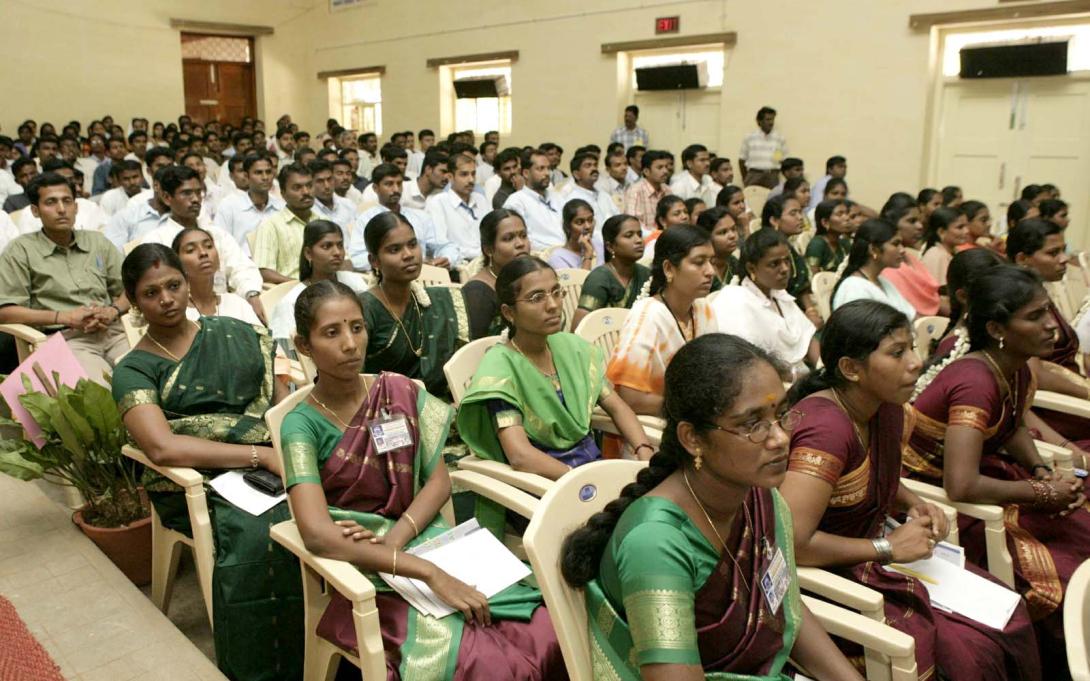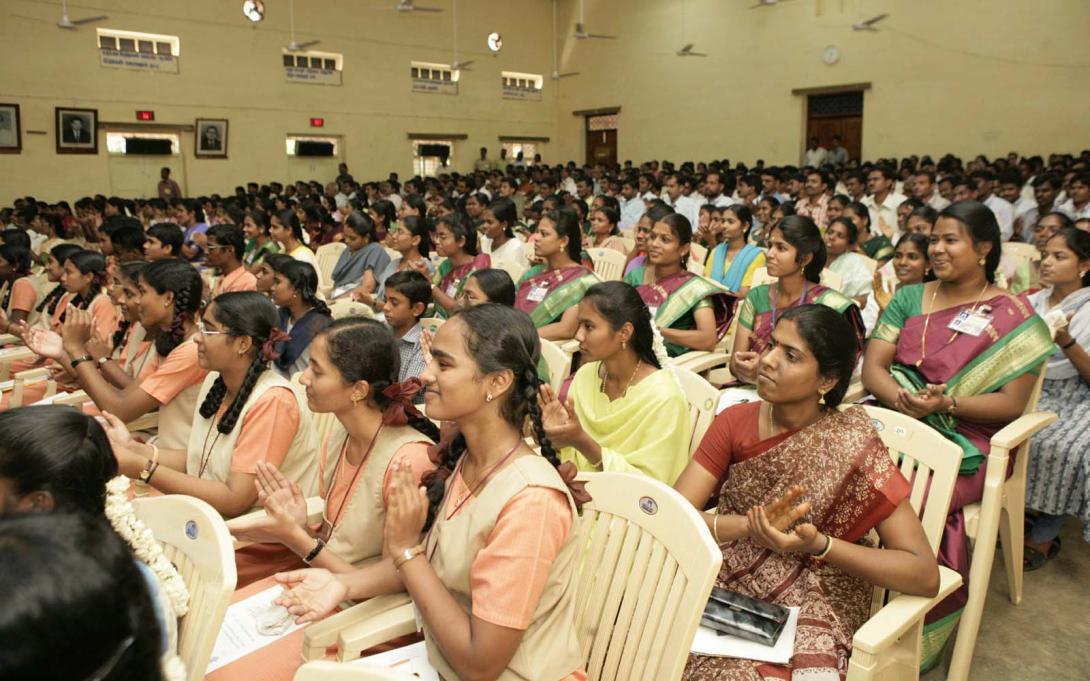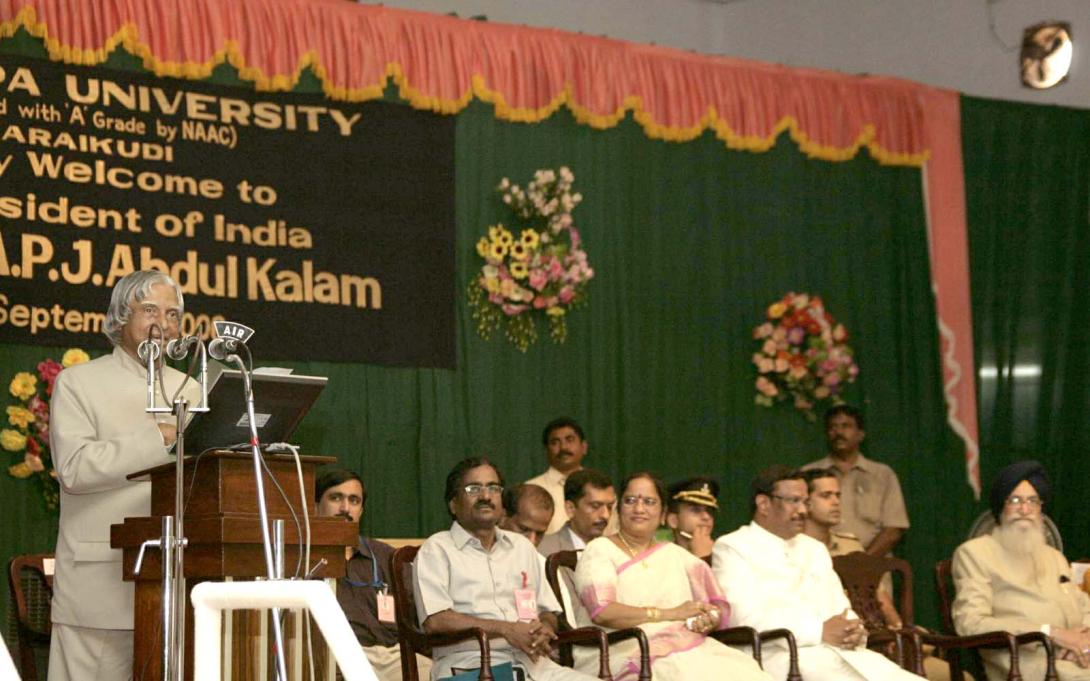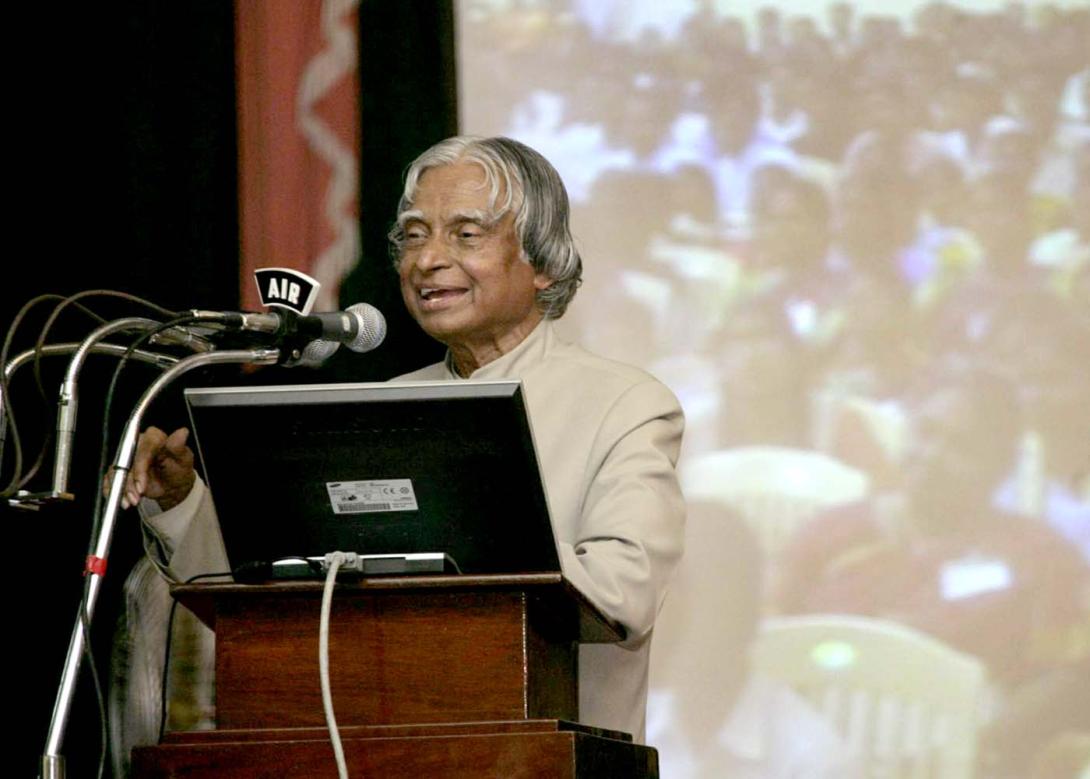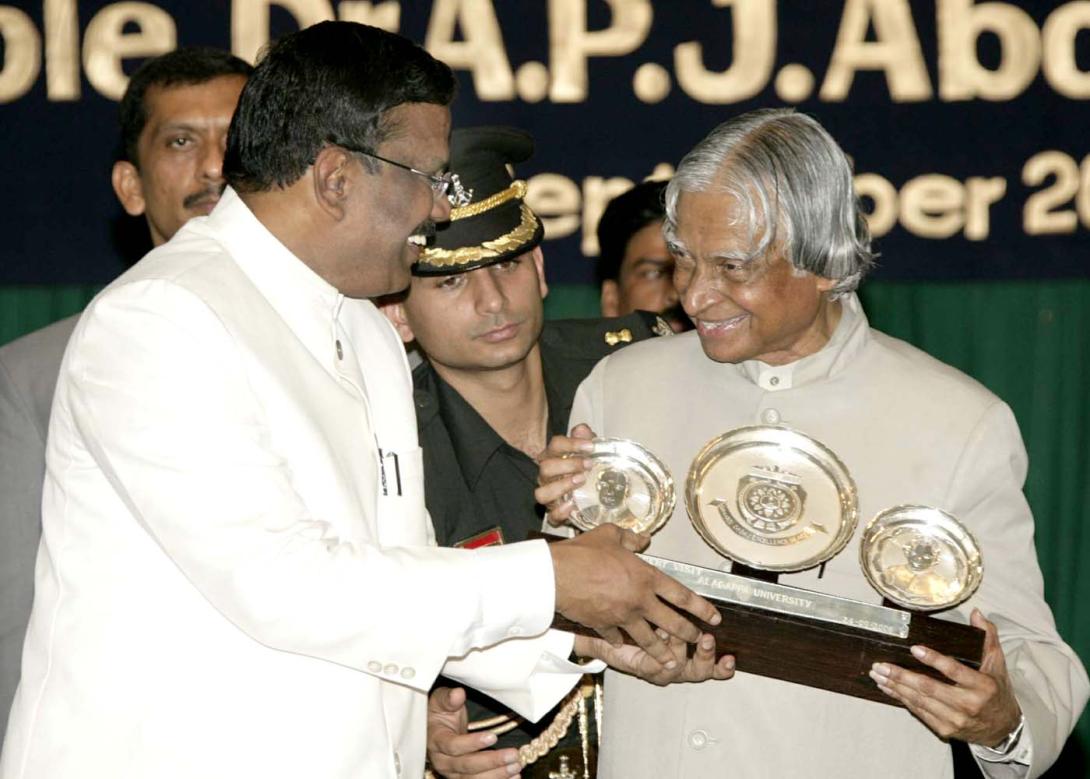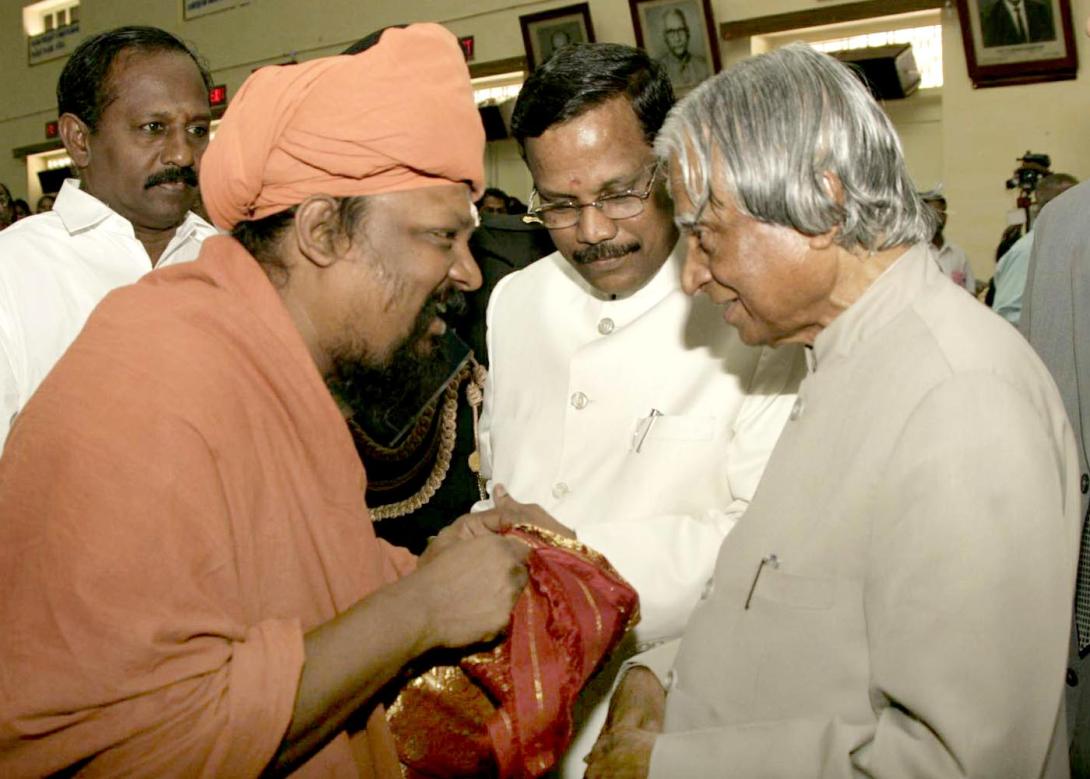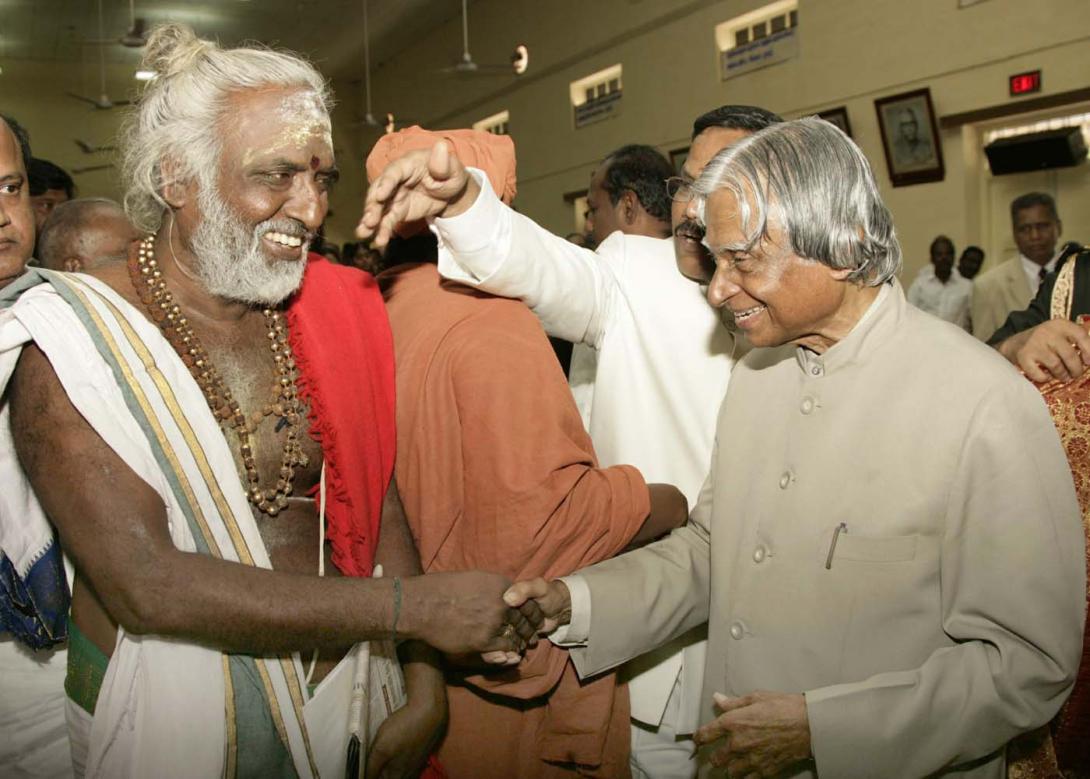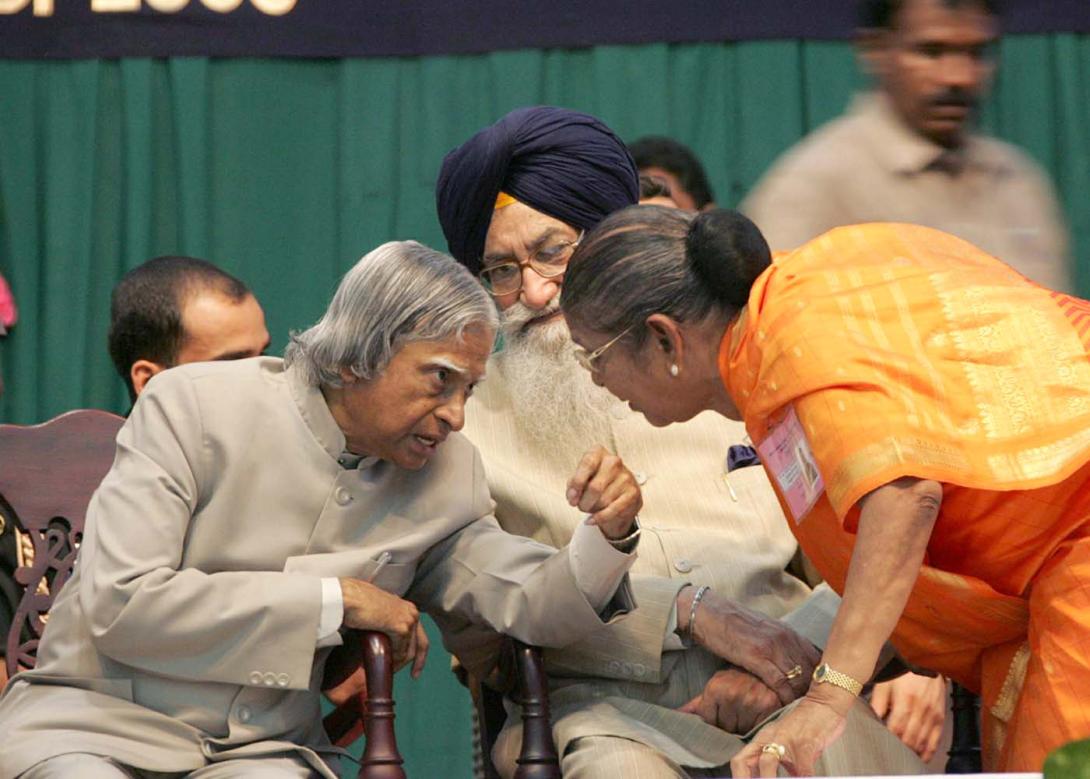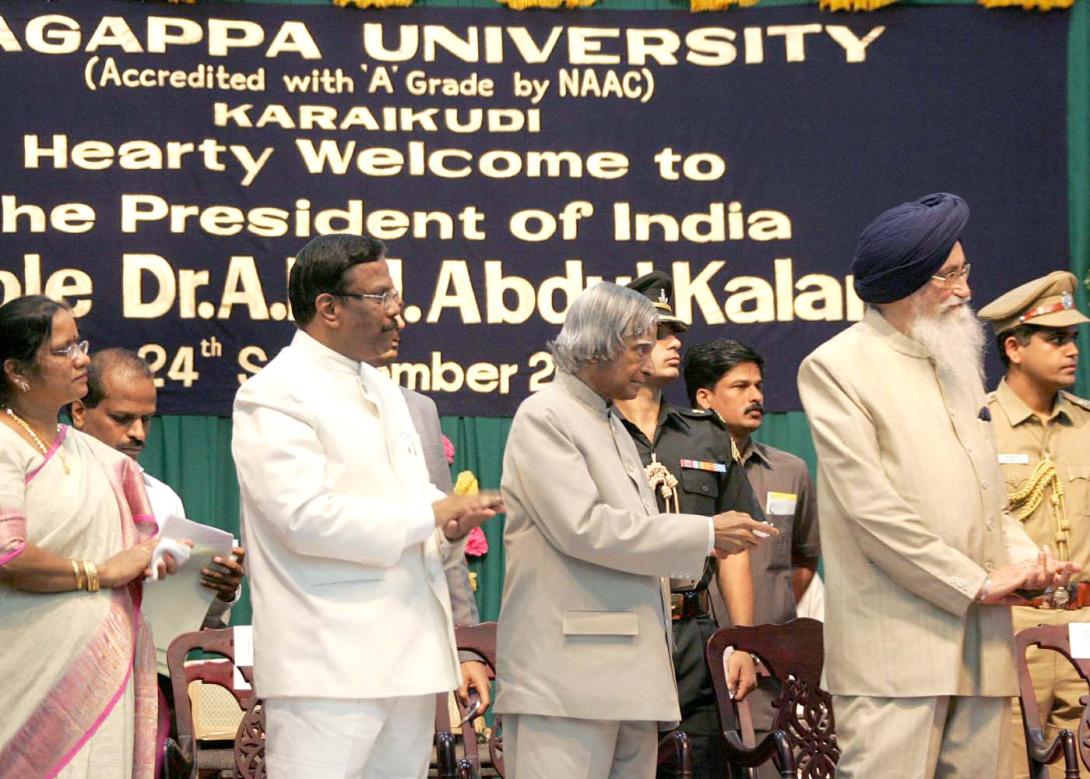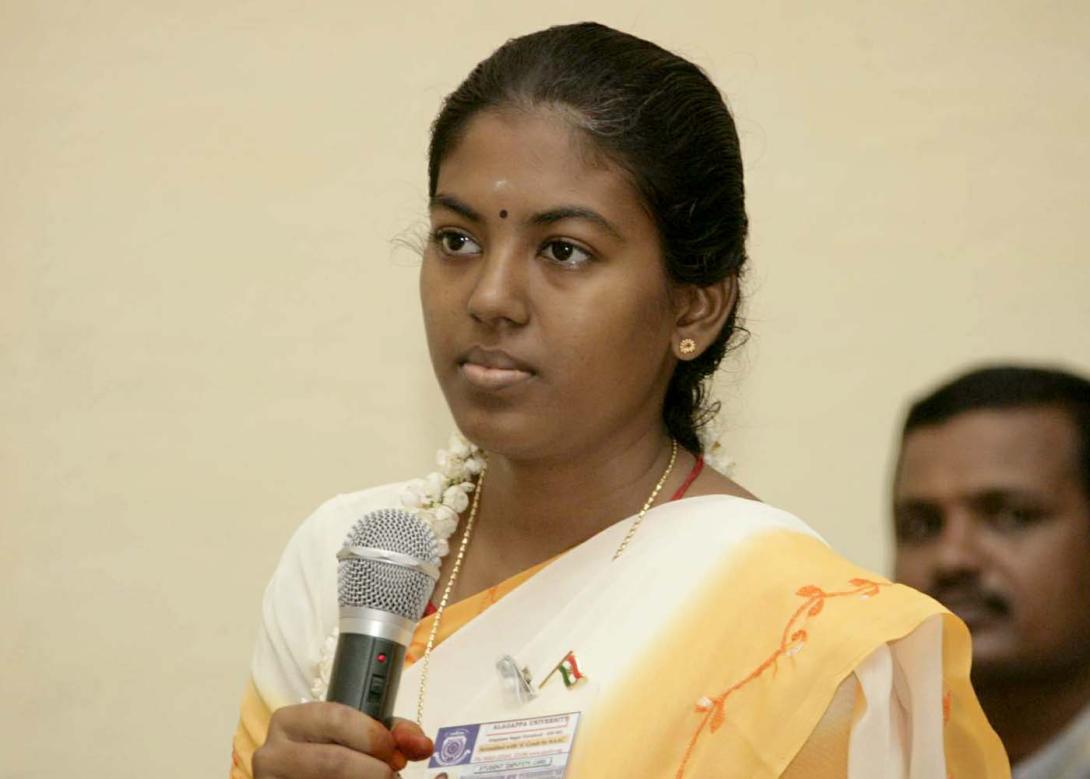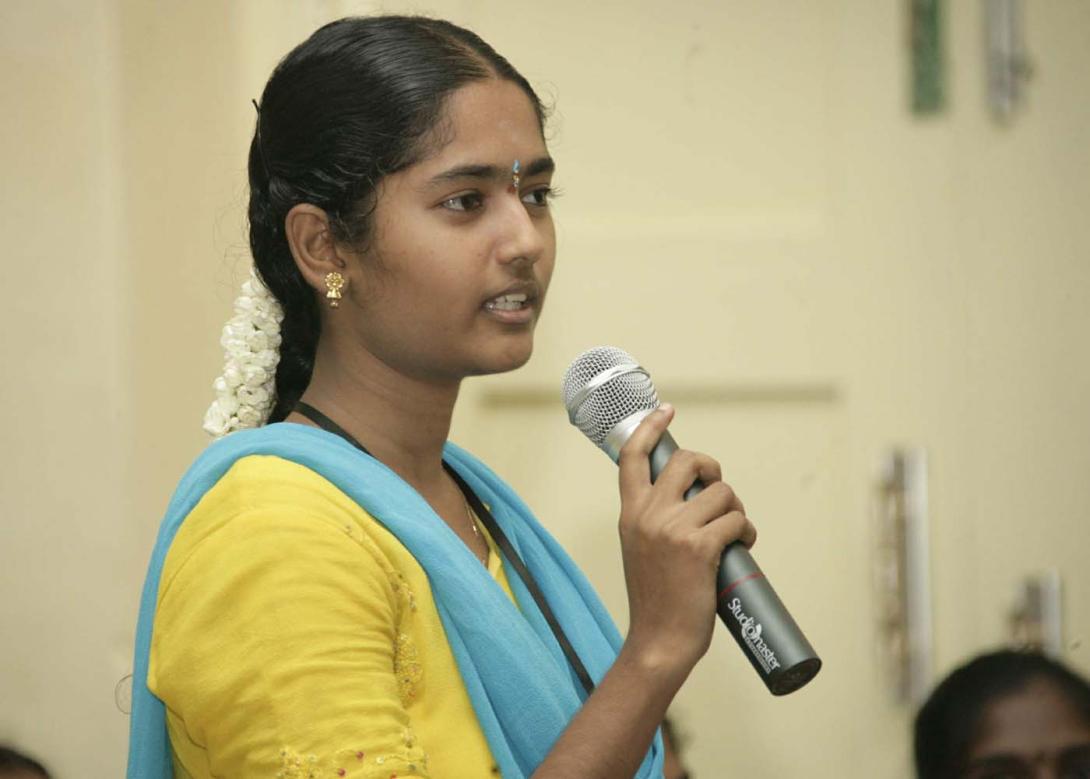Visit to Alagappa University and Address the Students, Karaikudi, Tamil Nadu
Karaikudi : 24-09-2006
Creative Leaders
"Inspired minds transcend limitations"
I am indeed delighted to be in the Alagappa University at Karaikudi. I take this opportunity to congratulate all the teachers, students and staff of this University and all those who have contributed during various phases of the university in promoting excellence in educational standards during the last five decades. The University indeed has created many eminent teachers, professors, scientists, economists and distinguished personalities. Your University is singularly fortunate to have had the association of the greatest education lover of this region Dr. Alagappa Chettiar who had the vision of creating multiple education institutions in Karaikudi fifty years back. Dr Alagappa Chettiar has created the ?we can do it? spirit among the youth of this slightly backward region by making it a place of academic excellence. His vision has resulted in improving the educational standards of this region over the last fifty years. I salute this great soul for all the service he has done for upliftment of education in Tamil Nadu.
Leadership from operating core of society
I was thinking what thoughts I can share with the members of Alagappa University today. I have selected the topic "Creative Leaders". I would like to narrate five examples of leadership which provides an insight into how selfless individuals with expert knowledge and determination to succeed contribute to societal development.
The first one is a story of Shri Shanmugappa who started his career as a porter and today he is an entrepreneur employing over 1,200 people. The second one exemplifies how a lady, socially alienated can become a major social reformer. The third example deals with the contribution made by an industry in promoting societal welfare particularly to the differently abled people of the society, the fourth one deals with an environmental upgradation mission. The fifth example pertains to technology denial management in an important defence programme. Let me highlight the leadership qualities from the operating core of the society.
Success through Hard work and Entrepreneurship
On 20th August 2005, I met Shri G. R. Shanmugappa who is presently Vice-President, All India Motor Transport Congress and President of Karnataka Lorry Owners Association. I would like to share how he faced life and has grown to the present position. In the year 1971, after failing in the 10th class, he moved over to Bangalore where he worked as a Porter in Bangalore Railway Station. In 1972 he joined Sasikala Transport Company and worked there as a labourer for one year. In 1973 he took up a job as labourer in the Brookebond India factory located in Whitefield. During the period 1975 to 1977, he worked in a transport company called Ramani Rangarao of Vijayawada where he was loading and moving coffee trucks to different places in the country.
During this seven year period, with his hard work with devotion in different places he had created a saving of Rs. 4000. With that money he bought an old Van in 1978 and started running the Van with the help of Sri Basavaraj, his brother who was a Driver and he himself became a cleaner. With the savings generated by running the Van he purchased an old Ashok Leyland truck in 1979. From 1980 to 1986 he kept on purchasing one or two trucks per year. All these days he continued his work in Ramani Rangarao Transport Office. In 1986 Shri Shanmugappa purchased one acre of land in Hosur Board and created a shed. He used this shed for blending tea for which he got a contract from Brooke Bond. By 1993 he was blending almost 100 tonnes of tea employing around two hundred and fifty members. In 1996 he started coffee packaging and sold off all the trucks and constructed a 40,000 square feet building in Basavapura village, Hosur Road land which he had purchased in 1986. By 1998 he was blending and packing ten tonnes per day of coffee employing around six hundred labourers. In 1999 he entered into premix coffee business in small quantities of 100 kg or 200 kg per day. Based on that experience he went into production of 10 tonnes per day premix coffee and eight tonnes per day premix tea employing over seven hundred labourers. In 2003 he bought 100 trucks for hiring to certain mines, coffee transportation and sub contracting to Larsen & Toubro, thus he became a fleet owner. In 2004, he converted the trucks as Milk Transporters for the Milk Dairy. In 2005 he visited Australia with his son who is a MBA student for establishing a milk dairy as a joint venture with an Australian firm for handling 9 lakh liters of milk per day. Simultaneously, he has established a factory which produces 100 tonnes of corrugated boxes per month for packaging premix coffee and premix tea. Today, he is employing around 1200 persons for running the trucks and also running premix coffee and tea business. Through this example, we can see how enthusiasm, hard work with devotion and above all the will to succeed made Sanmugappa, a successful entrepreneur, indeed he is a role model for any level of society. On his invitation, I inaugurated the Motor Transportation Congress, of which he had become the Chairman; I was happy and privileged to sit by his side to understand further about his dreams. India needs many Shanmugappa ? like leaders.
From Social alienation to Social Reformer
Last year, I addressed the members of CII Leadership Conclave at Bangalore. There I asked two questions to be answered by every one of the participants. The two questions were (a) What I have learnt so far? (b) What I will be remembered for? I asked the members to correspond with me through email. One of the members in the Conclave was Smt. Asha Ramaiah.
Smt Asha Ramaiah who is presently working as National Advocacy Officer for Indian Network for people living with HIV/AIDS and herself a HIV/AIDS patient since 1995, gave touching answers to both these questions.
As an answer to the first question "What I have learnt so far in my life?", she said,
The true learning in my life began when I had to face the reality of my situation. First, my husband?s family turned me away from their home and later even my father told me to leave our house. I became like any other abandoned woman to face alone my destiny as a fallen leaf would drift with the wind. At the first instance I had to preserve my life and then stand up and face up to the challenges of existence. Thanks to the strength of my womanhood, I could absorb the feeling of shock leading to a realization that my loved ones need support and I am responsible to make efforts to bring change in the lives of other people living with HIV/AIDS in India.
Today with constant efforts that I made, and the support that received from my fellow people living with HIV, I received an acceptance in my community that even people with high positions come to me for an opinion, guidance and counseling on various personal issues. My parents are proud that I have become a role model for others to follow. With a convinced family and a good peer support, I got remarried to another person living with HIV in the year 2000. He has given me ample support to work with my fellow people living with HIV for betterment of our lives.
I learnt when we had to decide upon having a child, how difficult it is for one to make decisions in the face of uncertainties; plunging into the unknown that may have the risk of having a HIV positive child. We decided to follow the medical guidelines to reduce the risk. We came victorious waiting for years when it was confirmed that our child has no infection. We learnt that, dreams do come true but only when you own them and accept the responsibility of any possible risk in pursuing them.
Now we have the responsibility for planning the future of my child for the next 20 years. Our quality life time can be utilized for imparting our parental responsibility by ensuring him education, security and future. I also learnt that I have the responsibility to share the message that all parents living with HIV/AIDS should participate in training programmes and plan their children?s healthy future.
For the second question "What I will be remembered for?" She said,
I will be remembered by the People living with HIV/AIDS of many parts of the country and my family, relatives and associates for the courage I showed, to stand up and face life and for my efforts in sharing the light I have acquired in the midst of my struggle.
Friends, the message we get from the above experience of Smt Asha is that as human beings we may get into a problem. But we should not get defeated. We should find out ways of converting this very problem to our advantage and succeed. The courage we see how the lady defeated the disease and most importantly she withstood the onslaught of alienation from her parents, husband and the society. This I call as indomitable spirit of a HIV affected person. Many Asha Ramaiah are needed to make the people suffering from HIV AIDS, leprosy, polio, cancer and TB feel comfortable and lead a normal productive life in our society.
Enlightened leadership in labour intensive industry
Recently, I participated in the conferment of TERI Corporate Awards 2004-2005. There I presented the award to a food manufacturing industry called Sakthi Masala (P) Ltd among many awards. This Unit produces curry powders, pappad, pickles and other food products. Over the last ten years the company has been actively recruiting disabled people for their establishment and today one third of the employees in the company are differently abled. The company also runs an exclusive project Sakthi Rehabilitation Centre, a home which provides specialized training and physiotherapy especially to children to make them feel confident and allow them to discover their unidentified potentials. Children with cerebral palsy, multiple disabilities and mental retardation are treated free of cost. All the differently abled employees are also given periodic therapy and counseling.
The company uses non-conventional energy resources thereby contributing to the energy independence of the nation. The company gives employment to over 200 rural people especially the destitute, widows and women. The company also ensures that it does not cause air, water and thermal pollution. It has the largest solar drying plant in Asia for drying spices and it has two wind mills which generate 45 lakh units of electricity every year. In addition, the company also runs a free hospital, offers education assistance to the children of its employees, promotes tree plantation and promotes rain water harvesting. What we learn from this Sakthi Masala company is the leadership quality of an enlightened leader, who cares for his people first and foremost and then for his business and profit. When I was talking to him, I felt the great leadership quality radiating from him and he was giving a valuable message to our upcoming industrial leaders of leadership with human values.
Leadership in Environment upgradation
The status of environmental cleanliness is one of the indicators of development of a nation. As a nation, we have to keep our environment clean and tidy including all our places of worship and rivers. I am delighted to learn the Kali Bein rivulet, the place where Gurunanak Devji is said to have received enlightenment. Over the years this rivulet has turned into weed choked drain. Recently river has become clean due to the efforts of Baba Balbir Singh Seechewal in partnership with the Punjab State Government. From the discussions, I understand that he organized people?s participation in stopping the massive flow of sewage into the Bein and cleaned 160 km long polluted and choked rivulet within the last four and a half years by deploying on an average 3000 volunteer pilgrims per day. Today one can feel the flow of fresh water in this rivulet released from the Tarkina Barrage by the government about a year ago. The revival of the rivulet has recharged the water table as the hand pumps that had become dry for the past 4 decades are now pumping out water.
While I was thinking how we should solve the problem of improving the environment of rivers and religious places, I find one of our enlightened citizens has taken the initiative and leadership and demonstrated the power of ignited individuals to solve societal problem. Let this model spread in all the places of divine worship and inspire the pilgrims to participate in the task of clean environment in water and air.
Leadership in Management of Technology denial
In the year 1992, LCA team decided to go for Digital-Fly-by-Wire Control System (FCS) for the Combat Aircraft as it is an unstable aircraft. At that time, the country did not have the experience in developing FCS. The only two countries who had the experience were France and US. The French company (Dassault System) had expertise in Hybrid systems whereas our need was an all Digital-Fly-by-Wire. Hence, it was thought appropriate to have a US partner who has the capability in design, development and integration of FCS on fighter aircraft. There were three candidates, General Electric Control that later became LMCS (now called BAe systems), Lear Astronics and Bendix. Finally, we chose LMCS for the contract at a costs of $ 40 million since they had the experience in designing FCS for F-16 Aircraft. Joint Team for design and development of the FCS was formed with ADE (DRDO Labs) and LMCS. The work share between Indian team and LMCS team was identified. Evolution of the SRS was the joint effort. The prototype flight control computer was to be done by ADE. Total system integration was the joint responsibility. Flight certification was to be provided by LMCS.
The contract progressed till 1998. Then, as you all are aware, India carried out its nuclear test on 11th May 1998. As soon as this event occurred the American Government imposed technological and economic sanction. Due to the sanction, LMCS broke the contract and retained all the Indian equipment, software and the technical information which were in their premises.
This was definitely a shock for the Indian team. Immediately, I called for a meeting of Directors of ADA, NAL, ADE, CAIR, HAL, National Flight Test Centre, Prof I.G. Sharma, a renowned control system specialist, Prof Goshal, a noted digital control system expert and guidance and control specialists from DRDL and ISRO. The FCS team explained to these members the situation arising out of the unilateral termination of contract by LMCS. We had a full day discussion on the methodology, which now needs to be followed, by which we can successfully complete the development of digital fly wire system and fly the LCA. The team after prolonged deliberations gave a structured method by which the development can be completed and the system can be certified for flight trials. They also mentioned that they will support the programme in whatever capacity they have to work with the ADE and ADA teams.
Based on the recommendations of the specialists we immediately strengthened the ADE software team with additional ten experienced software engineers from ADA. ADA was given the responsibility of verification and validation of software. Integrated flight control system review committee was constituted with Director (ADE) as Chairman and PGD (ADA) as Co-chair to support development and resolve all the conflicts arising between Control Law Team, Iron Bird, Software, Hardware and simulation. This team met once a week and brought out all the issues arising in different work centres and solutions were found. In addition, an Iron Bird review team was formed with Project Director Flight Control System as Chairman with members from HAL, ADA, ADE, certification agency (CEMILAC) and Test Pilots from National Flight Test Centre as Members. This team also met every week and resolved all the problems arising in the development and Test on Iron Bird. We also introduced participation of certification agency (CEMILAC) and inspection agency (CRI) in all these reviews. The aim was to see that any problem in any system is brought into focus at the earliest so that the solution can be found. In addition, we made it a point to have a special agenda in the monthly technical committee meeting on the development of integrated flight control system wherein Director (ADE), Director (NAL), Director (National Flight Test Centre), General Manager (HAL) presented the progress and problems. The confidence building took place by intensifying the tests. For example informal Iron Bird test was carried out over thousand hours and the formal Iron Bird test was conducted over hundred and fifty hours. Similarly, Pilot flew the simulator for more than two thousand hours. Thus, what we missed from the foreign partner, we compensated by enhancing the critical design review and increasing the test time to ensure safe man rated design of the integrated flight control system.
The entire team took the denial as a national challenge. They said if it were going to take three years we would do it in two years. If it is going to take twenty million dollars we will do it in ten million dollars. Our working hours was not eight hours. We will work twenty-four hours a day and complete the task. That is the time I realized the power of Indian Scientific Community, and the power of our country to face the challenge. I realized that no country could dominate us by imposing technological sanction or economic sanction. Power of scientific team will defeat the designs of any nation. Today I can proudly say that our scientists have designed, developed, tested, evaluated, integrated the flight control system in the LCA, which has logged more than 500 trouble free flight sorties in four different aircrafts. The challenge of the development is that the aircraft of this class is being designed for the first time; we introduced the state-of-the-art digital fly by wire technology in the very first prototype, of an aerodynamically unstable aircraft. We on our own developed the final hardware and software required for testing and evaluation of the control system in the aircraft, after the foreign partner leaves the scene and our own certification team which had no experience in certifying fly by wire aircraft, gains confidence and certifies the aircraft as flight worthy. Above all, the pilots who have never flown a prototype, which is unstable with a fly by wire system confidently, flew the aircrafts based on their flying experience in the simulator and the Iron Bird. Honest self-assessment, identification of area of uncertainty and all out effort to solve the problem were an important aspect of this programme. This is an example of Integrating leadership, that combined the strength of industry, R&D Labs, Academic, Air Force (the ultimate user) leading the country to achieve, what was then perceived as an impossible task. This is a demonstration of the Indian will that ?We can make the impossible possible.?
Conclusion
One of the very important ingredients for success of the vision of transforming India into a developed nation by 2020 is the evolution of creative leaders. I am giving a connectivity between developed India, economic prosperity, technology, production, productivity, employee role and management quality, all of which linked to the creative leader. Who is that creative leader? What are the qualities of a creative leader? The creative leadership is exercising the task to change the traditional role from commander to coach, manager to mentor, from director to delegator and from one who demands respect to one who facilitates self-respect. The higher the proportion of creative leaders, leaders with human values, the higher the potential of success of realization of ?developed India by 2020.?
My greetings to all the members of Alagappa University and my best wishes to all of you in promoting value based quality education to the youth of this region.
May God bless you.
Now, I would like to answer some of the questions asked by you.
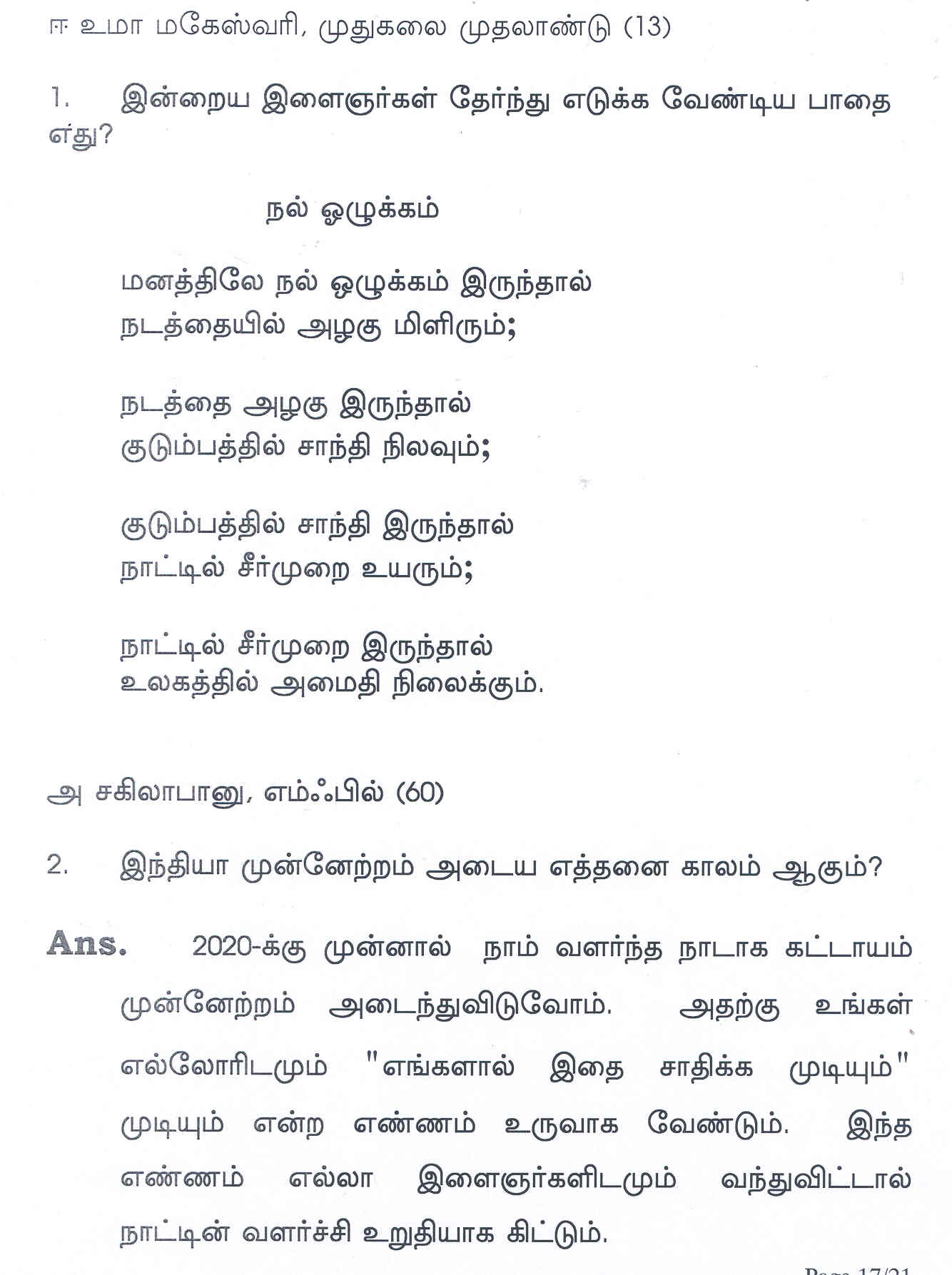
Arockia Helan, II Year, M.Sc. (93)
3. Though there are many schemes to develop rural areas they are still rural only, when will they become developed areas?
Ans: I am going to visit Periyar PURA today. It has a cluster of 65 villages with a population of one lakh people. It has been developed into a PURA complex leading to higher literacy, better health provision, productive employment for all the eligible villagers. The idea of developing rural areas is not to make them loose their rural culture. For example, fast urbanization and industrialization has lead to aberrant lifestyle leading to early occurrence of heart diseases among youth. We are suggesting change in lifestyle to improve the health of the individuals. The idea of rural development is to enable people to maintain our traditional lifestyle so that they enjoy a good health all the time.
K. Mithra, I Year, MBA (154)
4. What is the main reason for unemployment in India? Why you do not prefer writing about 2010 rather you went with 2020?
Ans: Not looking into the opportunities and markets both national and international is the cause of unemployment. Now, we are looking into all the opportunities which are available for enhancing the employment potential. For example, outsourcing IT enabled services is a big opportunity. Indian industries are making all efforts to capture larger share in the market. Similarly, we are embarking on a one product one village scheme in collaboration with the JETRO of Japan. This will open up a large international market for Indian products. When you look into the future for a country with a billion population you have to look well ahead. Since, the message of development has to travel down the line. That is the reason, we have chosen 2020 is our objective, since in a large system there is always a lack between concept, plan implementation and results. With a long term vision, we will be able to bridge the lag and succeed. Further, if we look for 2020 we would have definitely made partial progress in 2010 as well. For example, the people below poverty line has come down from 260 million to 220 million during the last five years.
C.T. Umayal, I year MBA, Computer Science (164)
5. How to reduce the large number of pending cases in Indian courts?
Ans: The Hon?ble Chief Justice of India has made a 28-point programme for bringing down the number of cases. Some of them are: (1) disputer resolution through human touch, (2) age analysis of cases (3) clubbing of cases which has got the same law point (4) Lok Adalats (5) mobile legal aid clinics (6) fast track courts (7) mediation and conciliation courts (8) working towards conflict free society and (9) creation of e-judiciary. In addition, the Courts are planning to have two shifts, some of the Courts have reduced their holidays and some of them working full time on Saturdays. These are the action being taken to reduce the pendency of cases. During the last one year, we are seeing good progress in this direction.
Rm. Umamaheswari, II year, MCA (247)
6. What you want to say for the Drug addicts, smokers to change their behaviour?
Ans: First I would like all of you to take a Oath with me.
1 As a student, I have a mission of achieving excellence in my studies and I will work for it without any deviation.
2 I, as a student, will have my parents and a good teacher as my role models.
3 I will not fall prey to the use of narcotic drugs and psychotropic substances.
4 In case, any of my student colleagues indulge in such practices, I will persuade him or her not to do so, because of its disastrous consequences.
5.Courage to invent, courage
to innovate,
courage to overcome the problem and succeed,
are indeed the qualities of the youth.
I will work and work,
to make my country Great,
and I will sing the song of India
In addition, parents at home, teachers in schools and colleges should provide challenging tasks to the students so that their mind is all the time occupied in constructive work. Also, the children must be advised to visit periodically, the places of worship according to their religion, so that they will get proper message regarding the art of healthy living. The combined action from home, school and workplace can definitely make the youth free from addiction.

